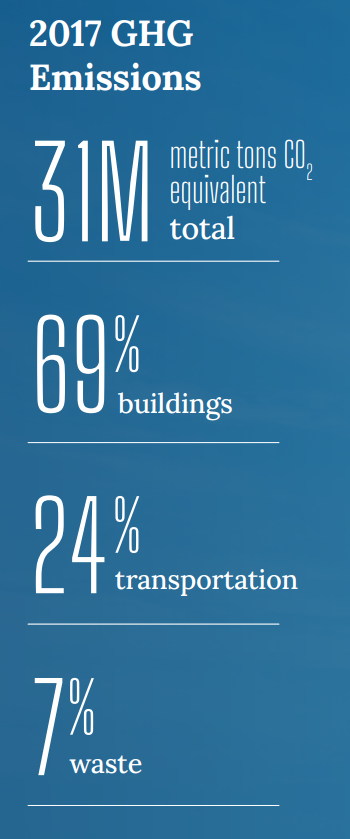Electrify Chicago
An independent tool for viewing City of Chicago building data
According to the
2022 Chicago Climate Action Plan,
69% of Chicago's emissions come from buildings, making
building emissions our biggest challenge and our biggest opportunity as a city
to tackle climate change. At Electrify Chicago, we showcase building performance using
publicly available data supplemented by community-submitted photographs and building
owners.
Start by looking at Chicago's buildings with the highest greenhouse gas intensity i.e. emissions per square foot. Large, efficient, buildings can perform much better than very inefficient small buildings on this metric.
New Article
📰 $30 Million In Missed Fines
The City Of Chicago failed to collect $30 million in potential fines from the building benchmarking ordinance, reducing transparency and accountability.
Legislative update! 🎉
As of late January 2024, legislation is being introduced to require new use more efficient forms of water and space heating, via the Clean And Affordable Buildings Ordinance (CABO), which will reduce the number of highly polluting and inefficient buildings that end up on this site.
If you're in Chicago,
write to your alderman to support the CABO!
Chicago Buildings by Greenhouse Gas Intensity
Note: Data includes large Chicago buildings with data from 2022, unless explicitly stated otherwise.
Note: This data only includes buildings whose emissions are reported
under the
Chicago Energy Benchmarking Ordinance. According to the City “As of 2016,
this list includes all commercial, institutional, and residential buildings larger than
50,000 square feet.” This dataset is also then filtered to only buildings with
reported emissions > 1,000 metric tons CO2 equivalent.
The latest year of data is from 2022, but we update the site regularly when new data is available, and some buildings may have failed to report that year, and only have older data available.
| Property Name / address | Primary Property Type |
Greenhouse Gas Intensity (kg CO2 eq./sqft) |
Total Greenhouse Emissions (metric tons CO2 eq.) |
|---|---|---|---|
|
Grossinger City Autoplex
🕰️
1530 N Dayton St
| Automobile Dealership | 8.2 kg/sqft | 2,264 tons |
|
Chicago Board of Trade Building
🚩
141 W Jackson Blvd
| Office | 8.2 kg/sqft
Highest 24%
| 12,840 tons #42 Highest
|
|
100 North Riverside Plaza
100 N Riverside Plz
| Office | 8.2 kg/sqft
Highest 24%
| 7,158 tons
Highest 4%
|
|
1606 E 50TH PL
1606 E 50TH PL
| Multifamily Housing | 8.2 kg/sqft
Highest 24%
| 488 tons
Lowest 25%
|
|
Maple Court Apartments
1120 1126 E 47th St
| Multifamily Housing | 8.1 kg/sqft
Highest 25%
| 413 tons
Lowest 18%
|
|
611 S. Wells Street Condo (The Vetro)
611 S Wells St
| Multifamily Housing | 8.1 kg/sqft
Highest 25%
| 2,352 tons
Highest 19%
|
|
Harper Library / Classics
1116 E 59th St
| Social/Meeting Hall | 8.1 kg/sqft
Highest 25%
| 967 tons
Highest 46%
|
|
North Grand HS -CPS
(CPS)
4330 W Wabansia Ave
| K-12 School | 8.1 kg/sqft
Highest 25%
| 1,661 tons
Highest 28%
|
|
Haley Elementary, Alex -CPS
(CPS)
11411 S Eggleston Ave
| K-12 School | 8.1 kg/sqft
Highest 25%
| 824 tons
Lowest 47%
|
|
KIPP Ascend-CPS
🕰️
(CPS)
1440 S Christiana Ave
| K-12 School | 8.1 kg/sqft | 513 tons |
|
Woodson South -CPS
🕰️
(CPS)
4414 S Evans Ave
| K-12 School | 8.1 kg/sqft | 583 tons |
|
650 W Lake Street
650 W Lake Street
| Office | 8.1 kg/sqft
Highest 25%
| 488 tons
Lowest 25%
|
|
Domestic Violence Courthouse
555 W Harrison St
| Courthouse | 8.1 kg/sqft
Highest 25%
| 1,513 tons
Highest 31%
|
|
Daniel Hudson Burnham Apartments
(CHA)
1930 W Loyola Ave
| Multifamily Housing | 8.1 kg/sqft
Highest 25%
| 811 tons
Lowest 47%
|
|
Fairbanks at Cityfront Plaza
240 E Illinois St
| Multifamily Housing | 8.1 kg/sqft
Highest 25%
| 4,766 tons
Highest 7%
|
Data Source:
Chicago Energy Benchmarking Data
